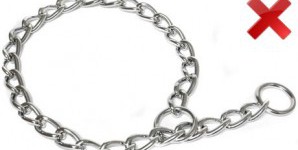
How to Stop Dogs Barking
Source: gohappydogs.com
Guest post: One of the most important things you need to do before applying these methods is to identify what causes your dog to bark.
If you love animals, you will love my articles on ethicalvegan.net. Thanks!

Source: gohappydogs.com
Guest post: One of the most important things you need to do before applying these methods is to identify what causes your dog to bark.

Source: respectyourdog.com
So your response to her supposed fear is to induce an element of pain around her throat and neck? Let’s say I threw a rope around your neck and starting pulling it whenever you were scared of something. Do you think that would help alleviate your fear?

Source: Dr. Becker
This is a sickening, heart-wrenching story I’d rather not repeat, but there’s an important message in it, so I hope you’ll bear with me.

Source: SHARK
What kind of person sells puppies from the back of a pickup, like watermelons?

Source: Dez McKay
Quick rundown of pinch/prong, choke and shock collars. The author even linked back to me! Important for anyone on the fence.

Source: respectyourdog.com
While getting your dog not to pull isn't complicated, it does require consistency. In this article I'll let you in on the top three most likely reasons your dog is a puller and the things you need to stop and start doing if you want things to change.

Source: respectyourdog.com
This article examines some of the aspects you should think about if you are contemplating breeding.

Source: youtube.com
Choke chains, prong collars, shock collars (aka e-collars) belong in the trash. This video explains why, and what you can choose instead - if you don't want to inflict pain.

Source: dogwelfarecampaign.org
Providing the public with information on behavior of dogs, the consequences of aversive training techniques, and where to go for advice.

Source: respectyourdog.com
Jerking has become so ingrained in many of us that we don't think about it anymore, we just react. We never stop to find out why the dog behaves the way he does.

Source: respectyourdog.com
A study of short and long term behavioral effects of shock collars used in training concludes that the potential for harm is high.

Source: respectyourdog.com
By promoting and talking of shock collars and training, regular dog owners are likely to become influenced and attempt to replicate the techniques themselves.

Source: respectyourdog.com
The short answer is yes. However, it is vital to understand that punishment doesn't have to be harsh or painful to be effective. In this article I will explain some of the terminology used to describe punishment, and give real world use cases for where it can be applied.

Source: positively.com
I haven’t yet met a person who wants to cause their dog pain. And yet many owners turn to shock collars (also known as electronic collars or e-collars) and other “quick fix” methods such as harsh jerking with a choke chain or prong collar to stop unwanted behaviors.

Source: respectyourdog.com
To those who do not agree with the info on this website, please take the time to read the science behind it, before making up your mind.

Source: nytimes.com
Essentially, National Geographic and Cesar Millan have cleverly repackaged and promoted a simplistic view of the dog’s social structure and constructed around it a one-size-fits-all, cookie-cutter approach to dog training.

Source: respectyourdog.com
Techniques such as pinning the dog to the floor will make dogs anxious and potentially lead to an escalation of aggression.

Source: youtube.com
Victoria Stilwell speaking with Jennifer Arnold of Canine Assistants about the benefits of positive reinforcement training methods.

Source: youtube.com
Victoria Stilwell explains the difference between constructive, non-forceful discipline and abusive, misunderstood discipline.

Source: youtube.com
Victoria and Spencer demonstrate how to teach a dog to leave a piece of food alone with the Positively Method.

Source: respectyourdog.com
Living in conditions that are either to hot, to cold, lack basic sustenance such as food and even water, forced to walk, sleep and live in their own feces and urine, hardly makes for an ideal place to raise healthy pups. Aside from all the physical problems, infections, disease and other complications the psychological aspects are horrendous.

Source: clickertraining.com
An estimate of what it costs to produce cheap dog food and how little of the money that is actually used on the edible part.

Source: positively.com
Victoria Stilwell: Dogs are not on a quest for world domination. They are not socialized wolves who are constantly striving to be ‘top dog’ over us, and they are not hard-wired to try and control every situation they are in. Contrary to what traditional training ideologies and much modern media would have you believe, most canine behavior problems stem from insecurity and/or a desire to seek and maintain safety and comfort – not from a desire to establish higher rank and be the ‘alpha’ over you Therefore, teaching dogs ‘who’s boss’ by forcing them into ‘calm submission’ is precisely the opposite of what they really need in order to learn effectively and overcome behavioral issues.

Source: respectyourdog.com
What follows are common reasons and situations in which children get bitten, so you as a parent can take appropriate measures in educating and supervising your child.

Source: respectyourdog.com
Cesar Millan is not a man of reason. Much like a religious fundamentalist, he turns a blind eye to sound logic, reason and what we currently know to be best based on scientific findings. He might mean well (or maybe all he craves is attention), but that doesn't change the fact that he's wrong.

Source: respectyourdog.com
Every time the media covers a dog bite, the number of commentators calling for the dogs death (even in cases where no one were injured beyond superficial cuts and scratches) always amazes me. Adding to the stupidity, is that there's always those who make ridiculous claims like "once a dog has tasted blood, there is no going back and the dog is a lost cause, therefore it should be killed".

Source: youtube
Speaking at the 2007 EG conference, trainer Ian Dunbar asks us to see the world through the eyes of our beloved dogs. By knowing our pets' perspective, we can build their love and trust. It's a message that resonates well beyond the animal world.

Source: respectyourdog.com
Aside from the sometimes physical restrictions and discomfort that goes along with silly costumes, you should know that this humanization of dogs can inhibit your dogs ability to communicate with other dogs.

Source: respectyourdog.com
I recently met a woman with an obese dog. She was nice so we started talking. She told me that she was aware of the weight problem and that together with her vet, they had put the dog on a strict diet.

Source: respectyourdog.com
Using choke chains on your dogs? Then you should see some of the scientific studies proving how physically and mentally dangerous this is.

Source: respectyourdog.com
A lot of times when a dog jumps, trainers will advocate squeezing the dogs paws, kneeing him in the chest, squirting lemon juice in his eyes or even rolling him over. This is abuse. Rather, to effectively prevent jumping we must understand why it occurs.

Source: respectyourdog.com
One of the easiest and most logical ways to determine whether you are feeding properly is to inspect your dogs waste. If his waste is firm, doesn't smell too bad and doesn't come in to large quantities relative to his size then you're probably okay. If on the other hand his stools are often soft, sometimes almost liquid (think diarrhea), smell horrible and are produced in large and frequent quantities, then you have a problem.

Source: examiner.com
This article takes an in depth and unbiased look at dog training today, and sheds light on some of the misdirections we as a society have taken towards the way we treat and co-exist with our dogs.

Source: lifewithdogs.tv
An extensive interview by John Bell Young from lifewithdogs.tv covering many aspects of the human-dog-relationship. While long, it's well worth the read.